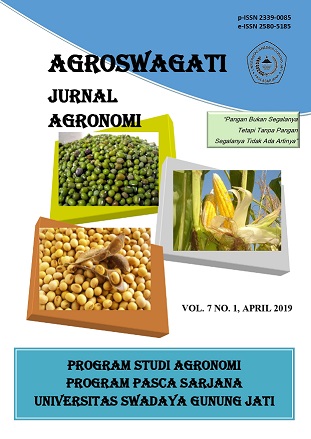ANALISIS FAKTOR – FAKTOR PRODUKSI USAHATANI PADI GOGO DI KABUPATEN KEBUMEN
DOI:
https://doi.org/10.33603/agroswagati.v7i1.2845Kata Kunci:
Production Factors, Farming, upland, Inpago 8, Situbagendit, SitupatenggangAbstrak
The efforts to increase rice production is still focused on irrigated paddy field, especially by intesification. On the other hand, there are other land resources, such as dry land that can be used for rice extensification by cultivating upland rice. Dry land area in Kebumen regency reaches 88.364 ha. This number gives a significant meaning to the total rice production in Kebumen. The objective of the study was to investigate the variability of the farming bussiness and the factors influencing upland rice production in Mirit district, Kebumen regency. The variability of farming bussiness in the regency could be seen from several thing. Upland rice varieties (Inpago 8, Situ Bagendit, dan Situ Patenggang) used in one planting cropping pattern per year. Planting was carried out by tugal (3-4 seeds/hole). Seeds used were non-labeled and produced from government assistance of farmers’ group. Manpower was needed at land cultivation, planting, harvesting, threshing, and drying of the paddy. The workforce mostly were men and came from farmer’s family. The women were only utilitized on planting activity. F test showed that the number of workers, seeds, urea, SP, and KCl, NPK, compost fertilizer, and seeds’ type were simultaneously affecting production result and t-test indicated that the number of SP, NPK, and manure fertilizer partially affecting the production of upland rice.Referensi
Aulia, Avenia Nur. 2008. Analisis Pendapatan Usahatani Padi Dan Kelayakan Usahatani Vanili Pada Ketinggian Lahan 350-800 M Dpl Di Kabupaten Tasikmalaya (Studi Kasus: Desa Cibongas, Kecamatan Pancatengah, Kabupaten Tasikmalaya. Skripsi Program Studi Ekonomi Pertanian dan Sumberdaya Fakultas Pertanian. Institut Pertanian Bogor. Bogor.
Bantulkab. 2008. Budidaya Padi. http://warintek.bantulkab.go.id/web.php?mod= basisdata &kat =1&sub=2&file=60. Diakses pada tanggal 20 Oktober 2015 pukul 19.30.
BB Padi, 2015. Deskripsi Varietas Unggul Baru Padi. Badan Litbang Pertanian. Kementerian Pertanian
BPS Provinsi Jawa Tengah, 2013. 'Luas Panen, Produksi dan Produktivitas Padi Sawah/Padi Ladang dan Jagung Menurut Kabupaten/Kota di Jawa Tengah Tahun 2013. http://jateng.bps.go.id/linkTabelStatis/view/id/976’ Diakses pada tanggal 9 Oktober 2015 Pukul 10.00.
BPS, 2014. Curah Hujan. http://kebumenkab.bps.go.id/curahhujan. Diakses pada tanggal 9 Oktober 2015 Pukul 10.00.
Ghozali, Imam. 2011. Aplikasi Analisis Multivariate dengan Program IBM SPSS 19. Semarang : Universitas Diponegoro.
Hafsah, M.J. 2004. Potensi, peluang dan strategi pencapaian swasembada beras dan kemandirian pangan nasional melalui proksi mantap. Makalah Seminar Padi Nasional, 15 Juli 2004, Sukamandi. hal. 1-19
Kebumenkab. 2015. Geografis. http://www.kebumenkab.go.id/index.php/ public/page/ index/ 23. Diakses pada tanggal 20 Oktober 2015 pukul 19.00.
Purnamawati, Heni dan Purnomo.2007. Budidaya Delapan Jenis Tanaman Pangan Unggul. Penebar Swadaya. Jakarta.
Pusdatin, 2013. Perkembangan PDB Indonesia dan PDB Sektor Pertanian Triwulan I Tahun 2013. Buletin PDB Sektor Pertanian. Volume 12, Nomor 2, Juni 2013.
Raharjo, Puguh Dwi. 2010. Teknik Penginderaan Jauh Dan Sistem Informasi Geografis Untuk Identifikasi Potensi Kekeringan. Makara, Teknologi, Vol. 14, No. 2, November 2010: 97-105
Suprihatno, Bambang dkk. 2009. Deskripsi Varietas Padi. Balai Besar Penelitian Tanaman Padi. Badan Penelitian dan Pengembangan Pertanian. Departemen Pertanian.
Wahyunindyawati. 2012.Pengaruh Faktor-Faktor Produksi Terhadap Keuntungan Usahatani Padi. Prosiding Seminar Nasional Competitive Advantage II, Vol 1, No 2 (2012).
Unduhan
Diterbitkan
Terbitan
Bagian
Lisensi
The Authors submitting a manuscript do so on the understanding that if accepted for publication, copyright of the article shall be assigned to Jurnal AGROSWAGATI, Sekolah Pascasarjana Ilmu Pertanian. Universitas Swadaya Gunung Jati as publisher of the journal. Copyright encompasses rights to reproduce and deliver the article in all form and media, including reprints, photographs, microfilms, and any other similar reproductions, as well as translations.
Jurnal AGROSWAGATI, Universitas Swadaya Gunung Jati and the Editors make every effort to ensure that no wrong or misleading data, opinions or statements be published in the journal. In any way, the contents of the articles and advertisements published in Jurnal AGROSWAGATIare the sole responsibility of their respective authors and advertisers.











